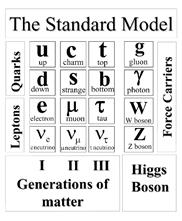
Interpretation:
All building blocks of matter of the standard model of particle physics needs to be described briefly.
Concept introduction:
All matter around the word is made up of elementary particles, the building block of matter. The main particle occurs in two basic type called quark and leptons.
Answer to Problem 123A
The main group consists of six particles, which are related in pairs or generations. The quarks and leptons are arranged in three generation. The main fundamental forces are of four types but in them the gravity is not explained by The Standard Model.
Explanation of Solution
The group of quark arranged six generations. The six quarks classify as up, down, top, bottom, charm and strange quark. The six leptons are similarly arranged in three generation. The six groups are as electrons, electron- neutrino, the muon, muon-neutrino, tau and tau-neutrino. The nature of muon, electron and tau are electrical charge while the neutrino is neutral in nature.
Now the other four fundamental forces are named as bonson. They classify as strong forces, weak forces,
Where the strong forces are carried by gluon, and the electromagnetic forces are carried by the photon, W, Z.
But the gravitational forces infinite range that is not explained by The Standard Model of physics.

These particles are the known as building basic unit of the matter. There are different types of forces which participated in maintaining the attraction between them. All these particles are experimentally detected by The Standard Model.
Chapter 4 Solutions
Chemistry: Matter and Change
Additional Science Textbook Solutions
Introductory Chemistry (6th Edition)
Essential Organic Chemistry (3rd Edition)
General Chemistry: Principles and Modern Applications (11th Edition)
Chemistry: A Molecular Approach (4th Edition)
Chemistry: A Molecular Approach
 ChemistryChemistryISBN:9781305957404Author:Steven S. Zumdahl, Susan A. Zumdahl, Donald J. DeCostePublisher:Cengage Learning
ChemistryChemistryISBN:9781305957404Author:Steven S. Zumdahl, Susan A. Zumdahl, Donald J. DeCostePublisher:Cengage Learning ChemistryChemistryISBN:9781259911156Author:Raymond Chang Dr., Jason Overby ProfessorPublisher:McGraw-Hill Education
ChemistryChemistryISBN:9781259911156Author:Raymond Chang Dr., Jason Overby ProfessorPublisher:McGraw-Hill Education Principles of Instrumental AnalysisChemistryISBN:9781305577213Author:Douglas A. Skoog, F. James Holler, Stanley R. CrouchPublisher:Cengage Learning
Principles of Instrumental AnalysisChemistryISBN:9781305577213Author:Douglas A. Skoog, F. James Holler, Stanley R. CrouchPublisher:Cengage Learning Organic ChemistryChemistryISBN:9780078021558Author:Janice Gorzynski Smith Dr.Publisher:McGraw-Hill Education
Organic ChemistryChemistryISBN:9780078021558Author:Janice Gorzynski Smith Dr.Publisher:McGraw-Hill Education Chemistry: Principles and ReactionsChemistryISBN:9781305079373Author:William L. Masterton, Cecile N. HurleyPublisher:Cengage Learning
Chemistry: Principles and ReactionsChemistryISBN:9781305079373Author:William L. Masterton, Cecile N. HurleyPublisher:Cengage Learning Elementary Principles of Chemical Processes, Bind...ChemistryISBN:9781118431221Author:Richard M. Felder, Ronald W. Rousseau, Lisa G. BullardPublisher:WILEY
Elementary Principles of Chemical Processes, Bind...ChemistryISBN:9781118431221Author:Richard M. Felder, Ronald W. Rousseau, Lisa G. BullardPublisher:WILEY





